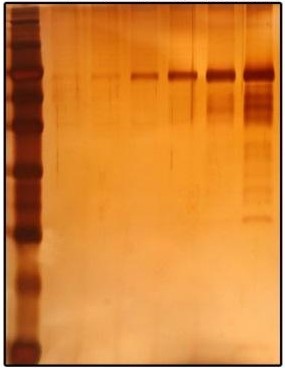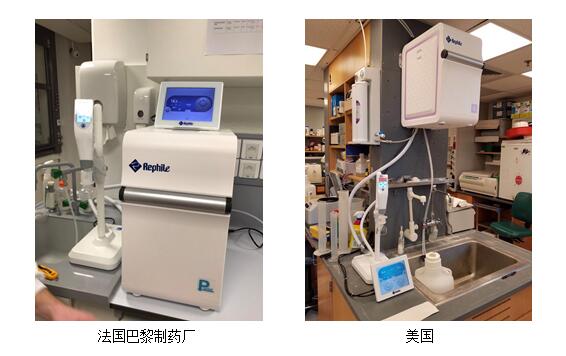[This article is the original article of Lefeng RephiLe company, please indicate the reprint, offenders. 】
Abstract: Shanghai Lefeng Marketing Department provides users with the basic steps of SDS-PAGE silver dyeing experiments and related pure water application programs. By explaining the effects of impurities in water on silver dyeing experiments, it explains in detail why EDI pure water should be used in silver dyeing experiments .
SDS polyacrylamide gel staining is a fundamental method for protein research. There are many dyeing methods. In practical applications, Coomassie blue staining (test dyeing) and silver staining are the most used methods.
Coomassie Brilliant Blue G250 is red in the free state, which combines with protein to turn blue, and the conjugate has maximum light absorption at 595 nm . Its light absorption value is proportional to the protein content, so it can be used for quantitative determination of proteins.
In the silver dyeing experiment, under alkaline conditions, silver ions are reduced to metallic silver, and the precipitate develops on the surface of the protein. After SDS- polyacrylamide gel electrophoresis was immersed in the protein solution in methanol, washed with a solution of silver nitrate silver staining, and then washed with water after color development with a sodium carbonate aqueous methanol.
Compared with test dyeing, silver dyeing has the advantage of high sensitivity. Many customers who do environmental, plant and breeding will do experiments in silver dyeing. The requirements for reagents for silver dyeing are relatively high, especially for the water quality in which pure water is used. Shanghai Lefeng ( RephiLe ) technicians propose the following silver dyeing experiments according to their own experience and the methods in the relevant literature:
First, instruments and reagents
Acetic acid ( 1% ), developer ( 2.5% sodium carbonate and 0.02% formaldehyde solution), ethanol ( 30% ), fixative (ethanol : glacial acetic acid : water ( 30:10:60 )), silver nitrate solution ( 0.1%) ), developer (add solution A in 850 mL of deionized water to 37 g NaCl and 37 g CuSO4 , then add concentrated ammonia until dark blue precipitate forms and then dissolve, dilute to 1 L ) and solution B (at 900 mL deionized) Add 436 g sodium thiosulfate to the water , dilute to 1 L ), add three times water to dilute, use immediately
Second, the test method
1. Separation of proteins by SDS- polyacrylamide gel electrophoresis;
2. Soak the gel in at least 5 times the volume of fixative, and shake gently for 4-12 h at room temperature to fix the protein;
3. Discard the fixative, add at least 5 times the volume of 30% ethanol, and shake gently for 30 min at room temperature ;
4. Repeat step 3 ;
5. Discard the ethanol, add 10 times of pure water (deionized water), shake gently for 10 min at room temperature ;
6. Repeat step 5 twice;
7. Discard the washing water, add 5 times the volume of silver nitrate solution, and shake gently for 30 min at room temperature ;
8. Discard the silver nitrate solution and rinse both sides of the gel with pure water (deionized water) for 20 s each side ;
9. Add 5 times the volume of fresh developer, shake gently at room temperature, and the dyed bands of protein appear within a few minutes, continue to the band clear;
10. Stop the reaction by washing the gel with 1% acetic acid, and rinse again with pure water (deionized water) water for 10 min each time .

The silver-stained gel can be converted to a photo by a gel imaging system or scanner, or it can be taken directly on a mobile phone.
In silver dyeing experiments, the quality of pure water (deionized water) is very important and plays a key role in the success of the experiment. Some users have neglected this point in the experiment. The water quality of pure water is not good, resulting in excessive chloride ion content. Silver nitrate precipitates when immersed, and precipitates on the glue. At the end of development, a chaotic image is seen, which affects the image. Dyeing effect.
The solubility of silver chloride is usually 2 ppm. Chloride ion is a common ionic impurity in water. If the chloride ion in water exceeds 2 ppm , impurities may occur. That is, for silver dyeing experiments, for pure water quality. The requirements are still relatively demanding, and general reverse osmosis pure water ( RO ) equipment is still difficult to meet the requirements.
In addition, the particles in the water will also adsorb silver ions to precipitate color, pollute the background, and even make a good gel into a "big face". Thus prepared out of water prior to use, but also be pre-filtered through a 0.22 or a 0.45 μ m filter to remove water and particulate matter.
Professionally speaking, silver dyeing water should be selected in accordance with the national standard "analytical laboratory water specifications and test methods" ( GB/T 6682-2008 ) (reference link http://rephile.com.cn/web/news-1686465.html Water above the secondary pure water - the conductivity should be at least 1 μS/cm . Therefore, silver dyeing water should use EDI pure water or DI pure water, and RO pure water can not meet the demand of silver dyeing water.
There are very few domestic manufacturers of laboratory EDI water equipment. Lefeng is the earliest supplier of pure water equipment for EDI laboratories in China. Lefeng's new Genie G intelligent integrated ultra-pure water system can simultaneously prepare EDI pure water and ultra-pure water. The water quality of EDI water produced by Genie G fully meets the silver dyeing experiment, and can also be used to prepare reagents for other related experiments; ultrapure water can be applied to the upstream and downstream of silver staining experiments and other protein research experiments, such as protein SDS-PAGE electrophoresis, Western Blotting et al. The RephiBio filter installed at the water intake terminal can prepare ultrapure water without pyrogen (endotoxin), nuclease and bacteria for biochemical analysis and molecular biology. Genie G is a two-in-one, highly integrated, fully capable of meeting the overall water needs of high-end life sciences laboratories. The quality does not lose imported equipment, and users can use it completely without worry.

About Shanghai Lefeng Biotechnology Co., Ltd.
Shanghai Lefeng Bio is specialized in the research, development, design and manufacture of high-end water purification and laboratory separation and purification products, and is committed to providing cutting-edge, high value-added innovative products for life sciences and biotechnology. The Lefeng product line includes laboratory pure water systems, Millipore pure water compatible consumables and laboratory separation and purification filtration products. Established ten years ago, Lefeng has established its own brand RephiLe (Ruifeng), with more than 30 patents and multiple software copyrights. Products are sold to nearly 90 countries and regions around the world. For more information on RephiLe products, please visit: Le Feng official website 
Pay attention to RephiLe Enterprise WeChat: Le Feng pure water, pay attention to Le Feng dynamic!
Â
Keywords: pure water , silver stain , protein , gel , SDS-PAGE, Shanghai Lefeng , RephiLe, Genie water purifier , Super-Genie water purifier
Â
Disposable Ear Loop Face Mask,Folding KN95 Mouth Mask,Anti-pollution Disposable Face Mask,3D Kn95 Face Mask
Dongguan Keyutai Mask Co., Ltd. , https://www.maskkytai.com